RARE 19th c BOLIVIA INDIAN SHOULDER BLANKET SW Character Tribal Weaving TM7851

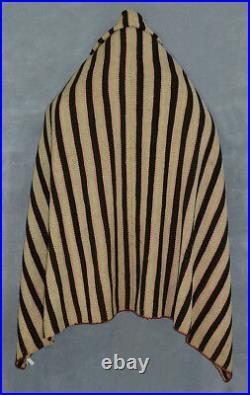
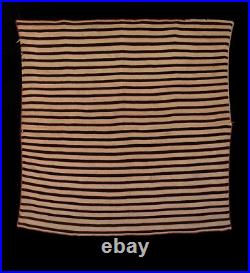
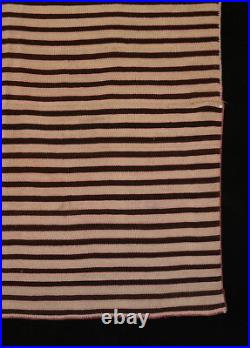
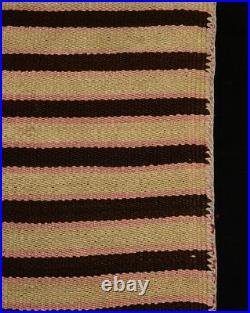

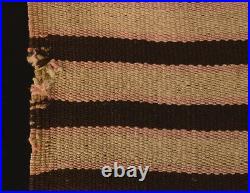
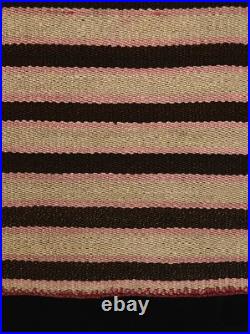
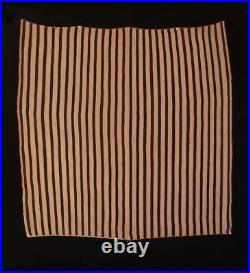

Experts in Finding Rare Ancestral Art for Your Collecting Interests. A RARE, ATTRACTIVE HISTORIC INDIAN SHOULDER BLANKET FROM THE BOLIVIAN PLATEAU. Origin: Southern Altiplano region between about 12,000 and 14,000 feet elevation, Department of Oruro, Bolivia, South America. This lot consists of an authentic and original indigenous Native American hand-woven warp-faced shoulder blanket with classic tribal striping. The blanket, called isi iki nya , chusa iki nya or suja iki nya , depending on local dialects, was woven by an Aymara-speaking Indian on a provisional horizontal staked-loom. Stake-looms are traditional prehistoric-style impermanent looms consisting of loose sticks. The textile was woven in two identical pieces that were joined together with a center seam. Warp-faced Andean blankets are almost always woven in two practical pieces. Any blanket more than about four feet wide would require the weaver to constantly and dramatically adjust his or her position while inserting and tightening the weft yarns. Traditionally, a woman weaver sits on her knees and inserts her shuttle stick, which carries her weft yarns, by leaning to the right or left. The sides of the textile cannot be so wide apart that she could not reach them with her extended arms. This is a rare old blanket of late-19th century to turn-of-the-19th century age that was very finely and expertly woven. The field iconography consists of a series of natural, very dark brown and natural cream-colored yarns in repeated stripes of equal width. Each of the stripes is flanked by a thinner, faded pinkish stripe, or line, that is about one-half the width of the wider stripes. The cream-colored yarns have a yellowish cast, which is usually found on much earlier 19th century textiles. Alpaca, llama and sheep wool were all employed in producing this beautiful piece, which is characteristic of many textiles of this age. The surface has a light sheen from age. Early in its history, fine and tight crochet edging was added for protection. The blanket resembles certain 19th century Southwest U. Blankets of Navajo and Pueblo origin. Please refer to the ANDES AMAZON DATING TERMS. Materials: Handspun, two-ply, fine alpaca, llama and sheep wool. Approximate Size: 65 inches by 59 inches. Condition: GOOD with no holes or dye run. One damaged edge (see photo detail) has crude repair, affecting a relatively tiny fragment of the entire textile. The very end of a center seam was recently re-sewn together. Please refer to the photos and the ANDES AMAZON TEXTILE “CONDITION” TERMS. DURING THE VIRUS PANDEMIC. International Bolivian postal service is happenstance during the C-19 pandemic. In 12 to 14 days. AND INCLUDE TRACKING NUMBERS FOR YOUR CONVENIENCE. ANDES AMAZON “DATING” TERMS. PREHISTORIC, PRE-COLUMBIAN, ANCIENT = Before around A. 18TH CENTURY = A. 19th CENTURY = 1800 to 1899. TURN OF THE 19TH CENTURY = 1890 to 1910. EARLY-20TH CENTURY = 1900 to 1933. MID-20TH CENTURY = 1934 to 1966. LATE-20TH CENTURY = 1967 to 1999. TURN OF THE 20TH CENTURY = 1995 to 2005. EARLY-21ST CENTURY = 2000 to Present. ANTIQUE = Over 50 years old. VINTAGE = Over 30 years old. CONTEMPORARY = Made in the last 5 years. CIRCA = Approximately/around/within a few years of. ANDES AMAZON TEXTILE CONDITION TERMS. Terms used to describe the physical condition of textiles can be subjective and vary greatly from one observer to another. What some others call mint condition, we call good; what others call excellent condition, we call fair. Following are explanations of the terms we use. MINT = Like new. Unused — as if recently removed from the loom. No wear or patina of any kind. These textiles may have nubs or even loose, uncut threads from the weaving process. EXCELLENT = Usually only lightly used, often guarded or stored for many years. There may be extremely light wear, patina and sheen from use. There may also be nearly undetectable light staining or soiling from use. The colors may have muted ever so slightly due to age or exposure, often improving the beauty of a textile. VERY GOOD = Usually lightly or only periodically used. The surface may be very lightly but evenly worn. There are no tears or distracting holes. There may be minimal surface discoloration. Vintage textiles may have lightly darkened yarn from use and age (staining and soiling). Overall, the textile will be in outstanding condition and at a displayable distance will appear perfect. GOOD = Usually moderately to well-used. There may be light to medium staining, isolated or throughout. Some parts of the textile may be worn or have very small holes, occasionally exposing hidden thread yarns. Edges may be lightly frayed. Surface discoloration due to age and exposure is common but often improving the appearance of a textile. There may be minor, light or isolated, dye run. Damage will not distract significantly from the textile when displayed. FAIR = Either well-used or moderately abused. Extensive wear is common as is some bleeding or dye run. In most 20th century cases, the colors have considerably faded. Sections of fringe or tassels may be missing. Textiles may be in otherwise excellent condition but with a single isolated sector of damage, that greatly reduces its aesthetic appeal. Most vintage tribal textiles on the market are in FAIR TO GOOD condition. POOR = Showing evidence of extreme usage and damage. These textiles do not display well and are primarily useful as study specimens or examples of sometimes very rare textiles. We believe the world deserves improving. We believe in a higher, aspiring destination for humanity. We know that conflicts decline through mutual respect. We know that understanding our differences leads to mutual wellbeing. We trust that our Mother Earth and our Universe provide unlimited resources for every man, woman and child to live in peace, happiness and love. As stewards of the human race, our intrinsic responsibility rests on improving our world as much as possible. Native groups, also known as tribal folk, original residents, indigenous people, aboriginals, First Nations, traditional ethnicities, autochthonous societies, autochthonal cultures, et. Dominated human existence until recently. At some point, of course, we all shared common ancestors regardless of current culture, creed or color. Regrettably, however, in the past 500 years or so, thousands of unique tribal groups disappeared due to misunderstanding and impudence. Uncontrolled aspects of colonialism, ethnocentrism, racism and politicization led to the direct and circuitous destruction of myriad native groups, each representing a valuable resource for our planet. Over 6000 of the nearly 7000 languages currently spoken face danger of extinction. The vast majority of those constitute ethnic indigenous tongues. We believe in cherishing and carefully supporting the very few Native groups that remain on earth, even while standing on the brink of losing them. Disconnecting with indigenous spirit, wisdom and traditional knowledge represents a loss for all of us. In many cases, physical creations represent our only resources for understanding past human beliefs and aspirations. For more than a quarter century, the professional interests of those behind ANDESAMAZON remain dedicated to documenting traditional South American indigenous cultures, especially through their material culture. Our field studies lead us to some of the most remote people on the continent. Through the years, we witnessed certain Native Americans existing nearly exactly as their ancestors did in prehistoric times and others jumping from 18th century existence to 21st century reality in the blink of an eye. The benefits of our ethnographic investigations manifest as valuable data related to linguistics, cultural history, ethno-environmental relationships, socio-cultural organization, cosmology, mythology, spirituality and of course, material culture. Our holistic approach to understanding the past through material arts contributes authentic information related to the people who created those pieces. Not only can beautiful and interesting objects enhance ones´ personal environment, but they also provide invaluable knowledge regarding different ideologies, unique ways of life and past or nearly extinct traditions. ANDESAMAZON suggests sharing with companions, friends and especially children, whatever understanding, knowledge and insights you obtain from our objects. In this small way, we feel inspired in preserving something of native cultures and making the world a better place. Thank you for working with us. THANK YOU FOR YOUR INTEREST AND SUPPORT. The item “RARE 19th c BOLIVIA INDIAN SHOULDER BLANKET SW Character Tribal Weaving TM7851″ is in sale since Thursday, December 27, 2018. This item is in the category “Antiques\Ethnographic\Native American”. The seller is “andesamazon” and is located in Santa Cruz, . This item can be shipped worldwide.
